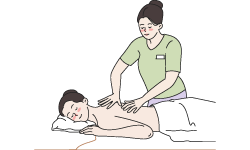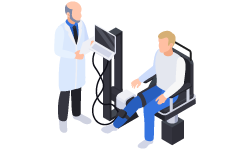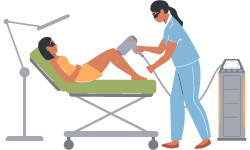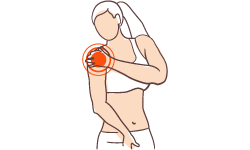

Wrist Sprain: Causes, Symptoms, and Physiotherapy Management
I. introduction
A. Wrist sprain definition
Wrist sprain is an injury that occurs to the ligaments of the wrist joint. These ligaments connect the bones in the joint and give it stability. It is commonly caused by extreme stretching or tearing of the ligaments, which is frequently triggered by a quick impact or a powerful twisting action of the wrist.
B. Risk factors and causes
Wrist sprains can occur as a result of a variety of activities and events, such as sports injuries, falls onto an outstretched hand, repeated motions, or mishaps while performing daily duties. Weak muscles, an insufficient warm-up, poor technique, and past wrist injuries can all increase the likelihood of a sprain.
C. Typical symptoms
Pain, swelling, bruising, limited range of motion, discomfort, and trouble grasping or bearing weight on the injured wrist are all common symptoms of a wrist sprain. The intensity of these symptoms varies according to the extent of the injury.
II. Diagnosis and Evaluation
A. Medical history: The physiotherapist will obtain a thorough medical history, including information on the beginning of symptoms, past wrist injuries, and pertinent activities or events before the sprain. This information aids comprehension of the context and any contributing elements.
B. Physical examination: A complete physical examination will be performed to determine the range of motion, stability, strength, and pain of the wrist. Special testing may be undertaken to identify the exact ligaments implicated and rule out other potential injuries or fractures.
C. Imaging tests (X-ray, MRI, and so on): Imaging studies, such as X-rays or MRI scans, may be done in some circumstances to determine the severity of the sprain, rule out fractures or other associated injuries, and aid in treatment planning.
III. Home Physiotherapy Treatment for Wrist Sprain
A. Acute Phase
- Rest and immobilisation: It is critical to rest the injured wrist and avoid activities that worsen the discomfort at first. Immobilization using a splint or brace may be advised to offer support and protect the affected ligaments.
- Cold therapy: Ice packs applied to the injured wrist for 15-20 minutes at a time multiple times each day can help reduce discomfort, swelling, and inflammation. Use a towel or cloth to protect the skin from the ice pack.
- Compression: An elastic bandage or compression sleeve wrapped around the wrist might help decrease edema and provide support. To minimize affecting blood circulation, it should be snug but not overly tight.
- Elevation: Elevating the damaged wrist above the level of the heart whenever possible can help minimize swelling by allowing fluid to drain.
- Pain control: To manage pain and suffering during the acute phase, over-the-counter or prescribed painkillers, as well as electrotherapy, may be indicated.
B. Subacute Phase
1. Range of Motion Exercises: To restore wrist range of motion, gentle and controlled workouts will be started. This could include wrist flexion, extension, ulnar and radial deviation, supination, and pronation.
- Eccentric Wrist Extension: Sit on a chair in front of a table with your forearm resting on the table and your wrist hanging over the edge of the table with your palm facing up; hold a dumbbell and flex your wrist with the assistance of your other hand; then, in a controlled manner, lower the weight so that your wrist extends; repeat as necessary. This is a wrist and elbow-strengthening workout.
- Wrist Flexion and Extension: Sit in a chair in front of a desk with your forearm supported on the desk and your wrist dangling over the edge of the desk, and then execute wrist flexion and extension as needed. This is a wrist mobility workout. Check Exercise Video
- Wrist Flexion Stretch with External Rotation: Sit up straight on a chair, flex your shoulder joint at 90 degrees so that your palm faces down softly, flex your wrist towards the floor with your other hand, and rotate your forearm out for a stronger stretch. You should experience some tension in your forearm extensor muscles. This is a wrist mobility and stretching workout. Check Exercise Video
- Wrist Flexion Stretch with Internal Rotation: Sit up straight on a chair, flex your shoulder joint at 90 degrees so that your palm faces down softly, flex your wrist towards the floor with your other hand, and rotate your forearm in for a stronger stretch. You'll stretch your forearm extensors. This is a wrist mobility and stretching workout. Check Exercise Video
2. Strengthening Exercises : Specific exercises targeting the wrist and forearm muscles will be suggested to build strength and stability as the pain lessens and the range of motion improves. Wrist curls, grip-building exercises, and eccentric training are examples of such workouts.
- Isometric Wrist Flexion: Sit up straight on a chair with your elbow bent at 90 degrees, cover your affected hand with your non-affected hand, and perform a wrist flexion against resistance. This is an isometric wrist-strengthening workout. Check Exercise Video
- Wrist Flexion Band: Sit in a chair in front of a desk, forearm on the desk. Take one end of an exercise band and tie the other end to a steady object. Flex your wrist against the band's resistance. This is an exercise to strengthen the wrists. Check Exercise Video
- Isometric Wrist Extension: Sit up straight in a chair, cover your affected hand's palm with your good hand for resistance, and extend your wrist against the resistance. This is a forearm, wrist, and elbow strengthening exercise. Check Exercise Video
- Wrist Extension Band: Sit in a chair in front of a table with your forearm lying on the table, hold one end of an exercise band and secure the end to a stable object, and do wrist extension against the band's resistance. This is a forearm and wrist-strengthening workout. Check Exercise Video
C. Chronic Phase
1. Progressive Strengthening: As the wrist's strength and stability improve, the emphasis will turn to more difficult strengthening exercises, such as resistance training and functional movements that imitate daily or sport-specific activity.
- Wrist Flexion Dumbbell: Sit in a chair in front of a desk, with your forearm resting on the desk, and flex your wrist against the resistance of the dumbbell. This is an exercise to strengthen the wrists. Check Exercise Video
- Wrist Extension Dumbbell: Sit on a chair in front of a table, with your forearm resting on the table, and perform a wrist extension against the resistance of the dumbbell. This is a forearm and wrist-strengthening workout. Check Exercise Video
2. Balance and proprioception training: To improve wrist stability and prevent future injuries, proprioception exercises, which entail enhancing awareness and control of joint position, and balance training will be included.
- Wrist Circles: Stand or sit on a chair with your arm outstretched in front of you and draw circles with your hand and wrist, first clockwise, then anticlockwise. This exercise helps mobilize your wrist. Check Exercise Video
3. Functional training: To guarantee that the wrist can handle the demands of these duties, functional exercises that duplicate specific movements required for work, sports, or daily activities will be introduced.
- Radial and Ulnar Deviation Dumbbell: Radial and Ulnar Deviations Dumbbell Sitting on a chair with your arm stretched out in front of you, grasping a dumbbell, and deviating your wrist towards the ceiling and towards the floor is the starting position for this exercise. This is a forearm and wrist-strengthening workout. Check Exercise Video
IV. Sport-specific Rehabilitation through physiotherapy:
Athletes or those active in sports may benefit from specialized rehabilitation programs focused on sport-specific motions, agility, and coordination.
-
Strategies for injury prevention and education: Education on proper body mechanics, ergonomics, and injury prevention measures will be presented. This may include advice on equipment selection, warm-up and cool-down regimens, and rest and recuperation procedures.
-
Manual Therapy: Physiotherapists may use hands-on treatments like joint mobilization, soft tissue mobilization, and stretching to improve tissue mobility and speed healing.
- Electrotherapy: Modalities such as ultrasound therapy or electrical stimulation may be utilized to alleviate pain, speed tissue healing, and improve circulation in the wounded area.
- Splint or brace: Depending on the progress of the individual, a detachable brace or splint may be provided to support the wrist during activities and avoid re-injury while allowing gradual movement.
Through personalized exercise programs and focused interventions, physiotherapy plays an important role in the entire care of wrist sprains, facilitating recovery, restoring function, and lowering the risk of re-injury.
Share views on Wrist Sprain: Causes, Symptoms, and Physiotherapy Management
Please keep your views respectful and not include any anchors, promotional content or obscene words in them. Such comments will be definitely removed and your IP be blocked for future purpose.


















 1st Feb 2024
1st Feb 2024
 23rd Jul 2023
23rd Jul 2023
 23rd Jul 2023
23rd Jul 2023
 18th Jul 2023
18th Jul 2023
 16th Jul 2023
16th Jul 2023